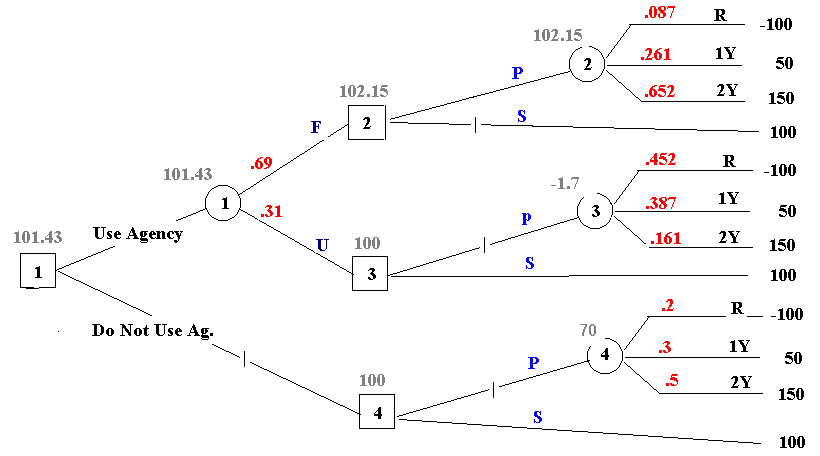Decision Making with Additional Information Example
Hale's TV production is considering producing a pilot for
a comedy series for a major network. While the network may reject the pilot
and the series it may also purchase the program for one or two years. Hale
may decide to produce the pilot or transfer the rights to a competitor
for $100,000. Hale's profits (in $ 000) are summarized below:
Pay-off Table
| |
States of Nature
|
| State Probability |
0.2
|
0.3
|
0.5
|
| Actions: |
Reject (R)
|
1Year (1Y)
|
2 year (2Y)
|
| Produce Pilot (P) |
$-100
|
$50
|
$150
|
| Sell to Competitor (S) |
100
|
100
|
100
|
For some consulting fee, an agency will review the plans
for the comedy series and give a favorable (F) or unfavorable (U) evaluation.
The reliability of the agency's evaluation is summarized in the following
conditional probabilities:
Reliability of the Agency evaluation
| |
States of Nature
|
| Review Outcomes: |
Reject (R)
|
1Year (1Y)
|
2 year (2Y)
|
| Favorable (F) |
P(F|R) = 0.3
|
P(F|1Y) = 0.6
|
P(F|2Y) = 0.9
|
| Unfavorable(U) |
P(U|R) = 0.7
|
P(U|1Y) = 0.4
|
P(U|2Y) = 0.1
|
In general the decision process follows the same pattern:
If the additional information is taken (it may not be wise to take it if
it is too expensive), the state probabilities are revised (on the
basis of the review result) and a decision is selected: If Hale decides
to use the agency's services they will submit to evaluation and get a favorable(F)
or unfavorable(U) evaluation for the project. They will use this
information (F or U) to revise the probabilities of the states of nature
and proceed to choose a decision (P or S).
Note4: Revised probabilities,
also called posterior probabilities, are conditional probabilities
in the form: Probability of a state of nature given a result
of evaluation.
Calculation of posterior probabilities:
-
Calculate the joint probabilities (probability of an outcome of evaluation
and a state of nature): For instance, P(F and R) = P(F|R) * P(R) = 0.3
*0.2 = 0.06. (Probability that a favorable evaluation will result and the
pilot will be rejected) etc.
Joint Probablities
| |
Reject (R)
|
1Year (1Y)
|
2 year (2Y)
|
| Favorable (F) |
.06
|
.18
|
.45
|
| Unfavorable(U) |
.14
|
.12
|
.05
|
-
Calculate the marginal probabilities of the outcome of the evaluation P(F)
and P(U). P(F) = P(F and R) + P(F and 1Y) + P(F and 2Y) = 0.06 + 0.18 +
0.45 = 0.69. This means that regardless of the eventual state of nature,
69% of proposals get favorable evaluation. In other words, if Hale submits
to evaluation there is 69% chance it will be favorably evaluated. Likewise,
P(U) = 0.14 + 0.12 +.05 = 0.31.
-
Posteriors are calculated as the ratio of joint probabilities to
marginal probabilities e.g., P(R|F) = P(F and R)/ P(F) etc.
Posterior Probabilities
| |
Reject (R)
|
1Year (1Y)
|
2 year (2Y)
|
| Favorable (F) |
.06/.69=.087
|
.18/.69=.261
|
.45/.69=.652
|
| Unfavorable(U) |
.14/.31=.452
|
.12/.31=.387
|
.05/.31=.161
|
-
Note5 To select a decision Hale will use for state probabilities:
-
the first row of the posterior probabilities, if the agency is employed,
and if the evaluation is favorable.
-
the second row of the posterior probabilities , if the agency is
employed and the evaluation is unfavorable.
-
prior probabilities, if the agency is not used
The sequence of Hales decisions: whether to use the agency and which alternative
to pursue is given as in the following DECISION TREE.

EVSI = 101.4835 - 100 = 1.4835 ($000)
Therefore if the evaluation will not cost more than $1,483, do the
evaluatiuon and produce the Pilot if the evaluation is favorable
Sell the project if the evluation is unfavorable . If the evaluation
costs more than EVSI= $1,483, skip the evlauation and sell the project..
To see a the same decision tree in Excel TREPLAN click here
